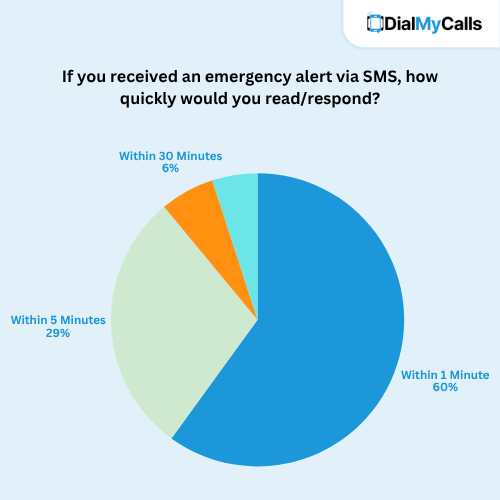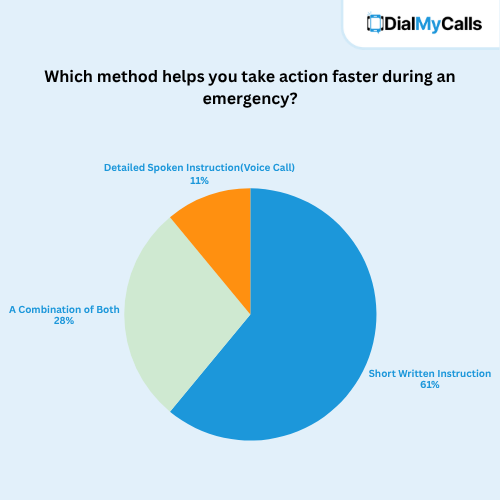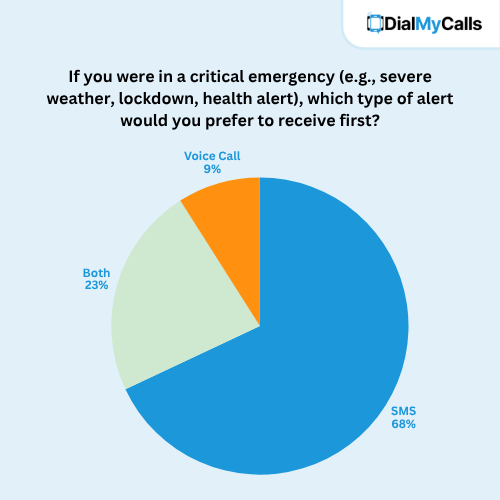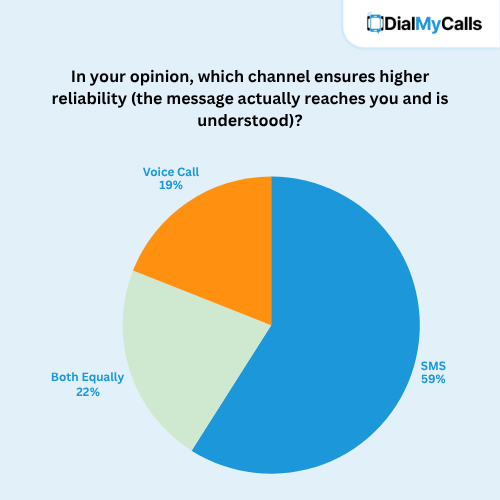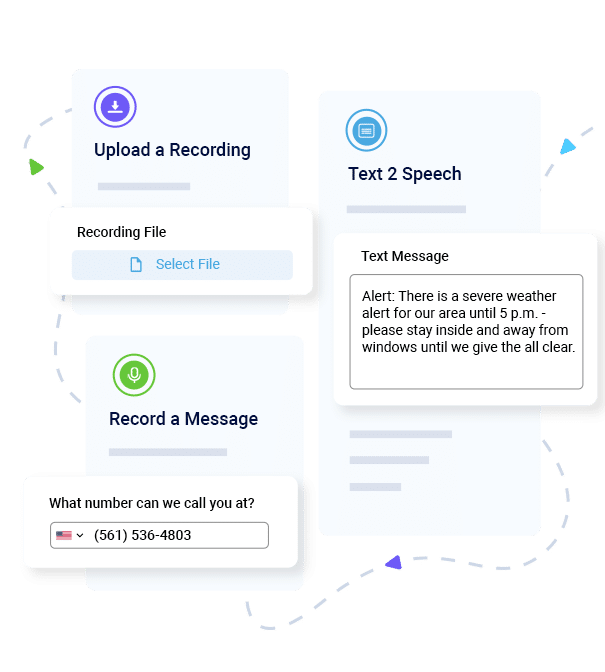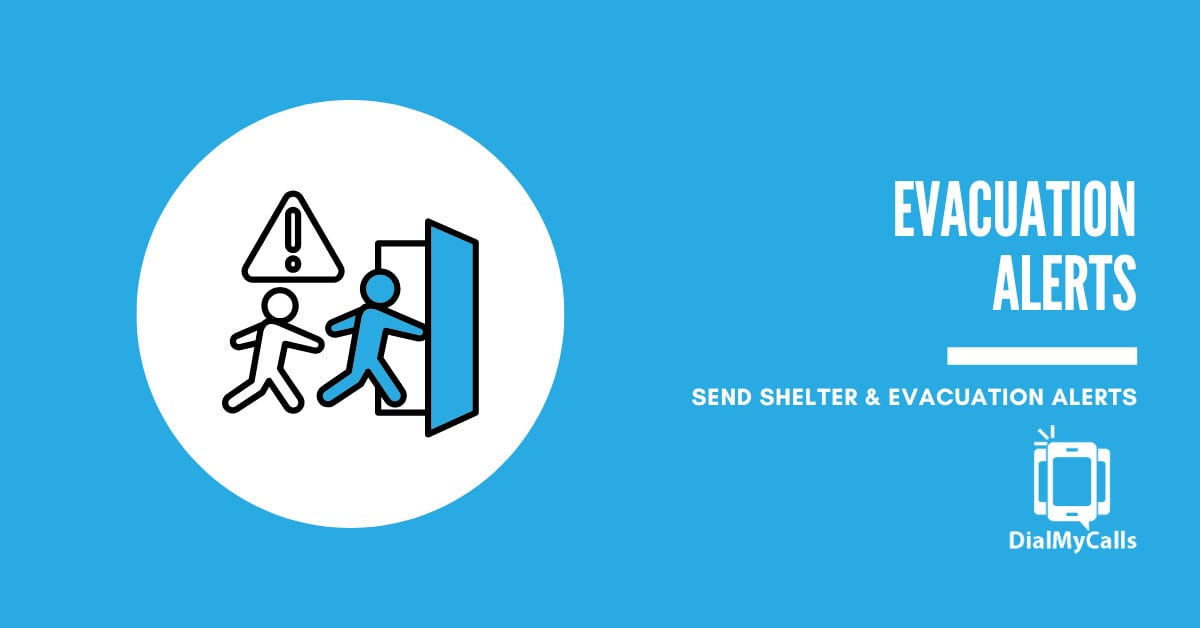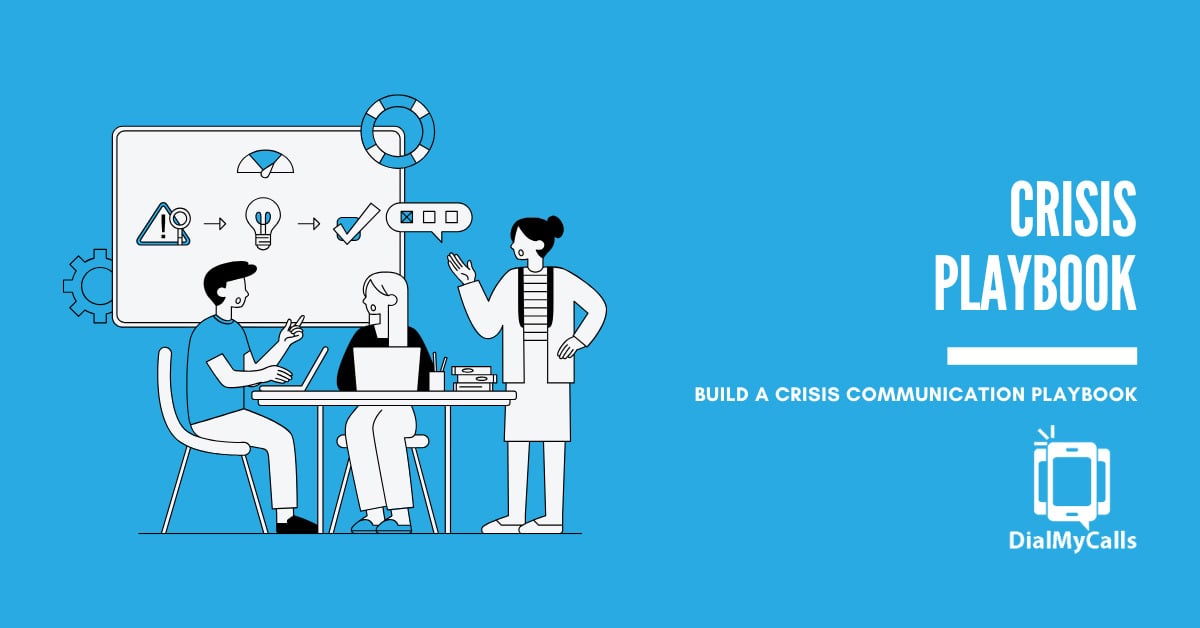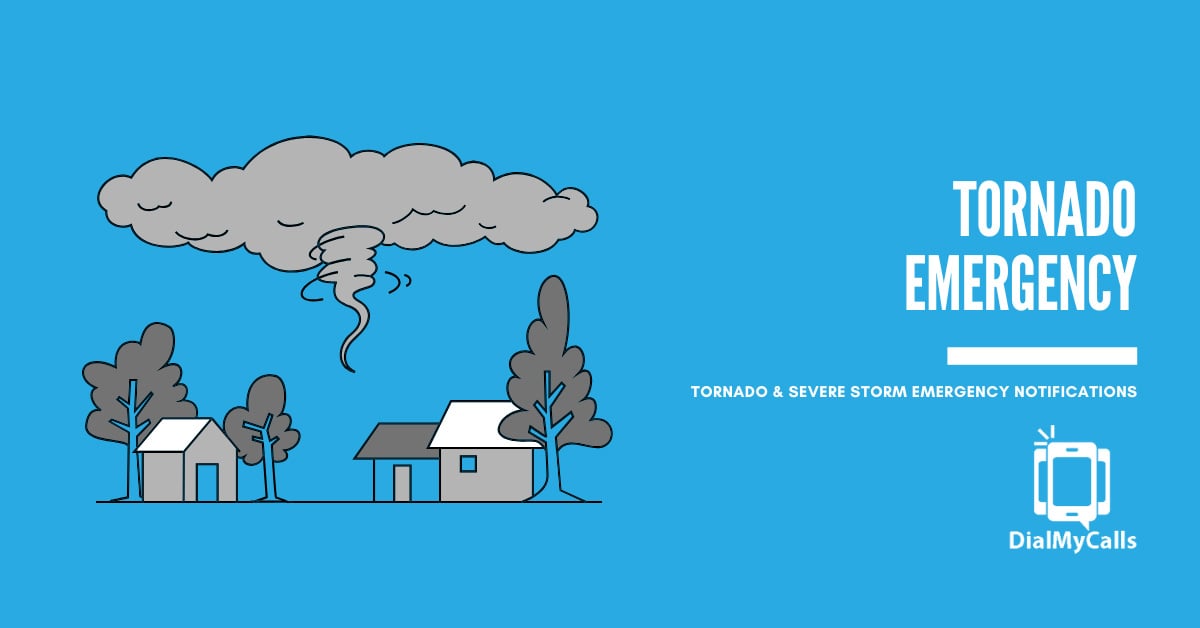SMS vs. Voice Calls for Emergency Alerts: Which Gets Faster Responses?
Posted by Tim Smith in Emergency Notification on November 12, 2025

When every second counts, should you send a text or make a call? Choosing the right channel for your mass notification system can determine how fast people respond. Most organizations rely on both channels, but few studies have measured which one truly prompts faster action during an emergency. Until recently, most insights came from small internal tests or anecdotal feedback.
To provide clear, current data, DialMyCalls conducted a nationwide survey in 2025. The study asked 1,000 U.S. adults how they react to emergency alerts sent by SMS or voice call. The results highlight how response speed, trust, and reliability vary depending on the channel—and why combining both methods remains the strongest strategy.

Survey Snapshot: Who We Asked and What It Reveals
The DialMyCalls 2025 survey included adults between the ages of 18 and 45, representing students, healthcare professionals, educators, office employees, and field workers from across the U.S.
Questions focused on three areas: how quickly people check messages or answer calls, which method feels more trustworthy, and how each affects decision-making during critical situations.
The survey aimed to remain neutral and reflect behavior in everyday and emergency conditions.
Key Takeaways from the Survey
The data shows clear patterns in how people engage with alerts. Texts reach more eyes faster, while calls trigger a stronger sense of urgency and human reassurance.
1. SMS Alerts Are Read Faster
Speed determines how quickly people see and act on an alert. According to the survey, 60% of respondents said they would read or respond to an emergency SMS within one minute, and another 29% would do so within five minutes. That means nearly nine out of ten adults check their texts within minutes of receiving them.
By contrast, 48% said they would answer a voice call immediately if they could, while 34% said they would respond within five minutes by calling back if they missed it. Fewer than one in ten said it would take them more than 30 minutes to react to a call.
Voice calls, however, are far from obsolete. They perform better in situations that demand immediate confirmation or verbal reassurance.
Want Faster Responses?
Try Instant Text Alerts With DialMyCalls SMS Broadcasting
2. Voice Calls Still Carry More Urgency
While text messages are faster to read, calls still hold the edge in perceived importance. In the survey, 32% trust SMS for urgent and accurate information, 49% trust both equally, and 19% trust voice calls more.
Meanwhile, 61% said they act faster when they receive short written instructions via SMS, but 28% said they move fastest when alerts combine both channels. A smaller share, 11%, preferred detailed spoken instructions by voice call.
Voice messages often communicate tone, authority, and seriousness in ways a text cannot.
3. The Most Effective Strategy: Use Both Channels Together
The data shows a clear pattern. No single channel guarantees full coverage. 68% prefer an emergency SMS first, 23% want both SMS and a call during major incidents such as severe weather, lockdowns, or public health emergencies, and 9% prefer a call alone. Only 9% preferred a call alone.
Many participants shared a common view in their open-ended responses: “Texts notify me instantly; calls confirm details.” That pattern mirrors what public safety agencies and schools have reported in their own alert systems. Texts deliver reach, while voice adds credibility.
DialMyCalls allows organizations to send both at the same time, without separate setups or multiple platforms. A message can go out by SMS, voice, or email simultaneously, ensuring no one gets left out.
4. SMS Scores Higher on Reliability and Reach
Reliability often determines whether an alert succeeds. In the survey, 59% said SMS ensures higher reliability, meaning the message reaches them and they understand it, compared with 19% for voice calls and 22% who rated both equally.
Calls face more obstacles. Among respondents, 25% said they had missed an important alert because it came by phone, while only 9% reported missing one due to SMS. Poor reception, voicemail delays, or reluctance to answer unknown numbers limit effectiveness. In fact, 43% said they rarely answer calls from numbers they don’t recognize, and 37% said they never do.
SMS delivery has fewer barriers. Texts arrive quietly, stay visible, and can be re-read anytime. One expert summarized it well: “Local texting feels personal; toll-free numbers feel automated.” That sense of familiarity improves engagement, especially during critical updates where every detail matters.
5. Voice Adds a Human Touch During Crisis
Even with faster read rates, SMS cannot replicate the comfort that a real voice brings. During crises that require calm and clarity, tone matters. Hearing a familiar voice or an official message helps reduce confusion and panic.
Voice broadcasting also helps reach people who may not be watching their phones for notifications. Workers operating machinery, driving, or working in noisy areas often hear calls before they can check messages. That makes voice alerts a practical backup for field-based teams.
Top Recommendations from the Data
The DialMyCalls 2025 survey highlights several clear takeaways for emergency communication teams. To improve response speed, reliability, and clarity, organizations should apply these data-backed practices:
- Use SMS for instant awareness: Texts reach people faster and stay visible even if they cannot answer right away.
- Follow up with voice calls for context and reassurance: Use voice to confirm instructions or add a personal tone after the first SMS goes out.
Beyond those two steps, teams can refine their emergency alert strategy through consistent testing and inclusivity:
- Run A/B tests on message timing and templates to learn which format prompts the quickest engagement.
- Keep messages concise, clear, and actionable to avoid confusion during high-pressure moments.
- Provide multilingual options to ensure every team member receives and understands critical information.
- Maintain updated contact lists so every employee or student stays connected, even if numbers change.
Keep messages concise, clear, and actionable to avoid confusion during high-pressure moments.
Conclusion

The DialMyCalls 2025 survey proves that both SMS and voice alerts play distinct but equally vital roles in emergency communication. Text messages reach people faster and more reliably, while voice calls convey urgency and reassurance that build trust. Together, they create a layered response system that saves time and reduces confusion.
Organizations that rely on a single channel risk missing part of their audience, whether because of unanswered calls or overlooked messages. Using both ensures broader coverage, faster awareness, and more confident decision-making.
Emergency communication works best when every contact receives the right message in the right format. Don’t wait for an emergency to test your system. Start your free DialMyCalls trial today and see how SMS + voice alerts can boost your response time.
Want Faster Responses?
Try Instant Text Alerts With DialMyCalls SMS Broadcasting
Author
Tim Smith is the Media Manager at DialMyCalls, where he has leveraged his expertise in telecommunications, SaaS, SEO optimization, technical writing, and mass communication systems since 2011. Tim is a seasoned professional with over 12 years at DialMyCalls and 15+ years of online writing experience.
Try Using DialMyCalls Right Now
Start For Free
Recent Posts
- How to Send Effective Shelter & Evacuation Text Alerts During Emergencies
- A Step-by-Step Guide to Building a Crisis Communication Playbook
- 6 Top Emergency Notification Challenges Schools Face and How to Solve Them
- 7 Best Practices for Tornado and Severe Storm Emergency Notifications
- 7 Best Practices for Church Emergency Notifications to Keep Congregations Safe
Categories
“I am a youth minister and have spent hours in the past calling students individually to remind them of an upcoming event or to get out an urgent announcement. With DialMyCalls.com, I cut that time down to about 1 minute. I also love how I can see exactly who answered live and how long they listened so I know if they heard the whole message. DialMyCalls.com is the best website I have stumbled upon all year! Thanks!”
Central Baptist Church
Try Using DialMyCalls Right Now
Start For Free
Author
Tim Smith is the Media Manager at DialMyCalls, where he has leveraged his expertise in telecommunications, SaaS, SEO optimization, technical writing, and mass communication systems since 2011. Tim is a seasoned professional with over 12 years at DialMyCalls and 15+ years of online writing experience.
Try Using DialMyCalls Right Now
Start For Free
Recent Posts
- How to Send Effective Shelter & Evacuation Text Alerts During Emergencies
- A Step-by-Step Guide to Building a Crisis Communication Playbook
- 6 Top Emergency Notification Challenges Schools Face and How to Solve Them
- 7 Best Practices for Tornado and Severe Storm Emergency Notifications
- 7 Best Practices for Church Emergency Notifications to Keep Congregations Safe
Categories
“I am a youth minister and have spent hours in the past calling students individually to remind them of an upcoming event or to get out an urgent announcement. With DialMyCalls.com, I cut that time down to about 1 minute. I also love how I can see exactly who answered live and how long they listened so I know if they heard the whole message. DialMyCalls.com is the best website I have stumbled upon all year! Thanks!”
Central Baptist Church
Try Using DialMyCalls Right Now
Start For Free
